HomeAngle Converter
Angle Conversion Calculator
Convert between degrees, radians, revolutions, and more—because every turn counts.Angle Converter
Convert from
Convert to
**Formula:
Discover Other Unit Converters
Updated on September 1, 2025
You can quickly convert among angle units with our Angle Conversion Calculator. Use it to switch between degrees, radians, gradians, and more instantly and accurately. This guide shows how the conversion calculator works, breaks down the formulas behind it, and helps you get fast, reliable results in seconds.About Our Angle Conversion Calculator
Written By Nadiba Rahman
Nadiba Rahman
Reviewed by Mrinmoy Roy
Mrinmoy Roy
Share This Post
URL copied!
What are Angles?
An angle is the amount of turn between two lines or surfaces that meet at a point, called the vertex. In simple terms, an angle is a measure that shows how much one line has rotated from another.Angles are measured using two common units: Degrees and Radians. A full circle is divided into 360 degrees, which is the most familiar unit used in everyday tasks. In contrast, a full circle is also equal to 2π radians, a unit mostly used in trigonometric functions like sine, cosine, and tangent.
Angles are essential in many fields, including geometry, trigonometry, mapping, and geography. A protractor, a semi-circular or circular tool marked with degrees, is used to measure angles accurately.
Angles can also be negative when measured in the clockwise direction. For example, -90° angle is equivalent to 270° measured counterclockwise.
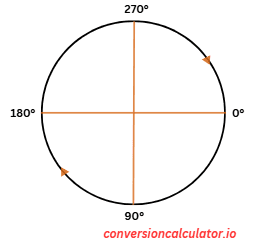
Types of Angles
The most common types of angles are:- Acute angle: An acute angle is one that measures less than 90 degrees.
- Right angle: A right angle measures exactly 90 degrees.
- Obtuse angle: An obtuse angle measures more than 90 degrees but less than 180 degrees.
- Straight angle: A straight angle measures exactly 180 degrees, forming a straight line.
- Reflex angle: A reflex angle measures more than 180 degrees but less than 360 degrees.
- Full angle: A full angle measures exactly 360 degrees, completing a full rotation.
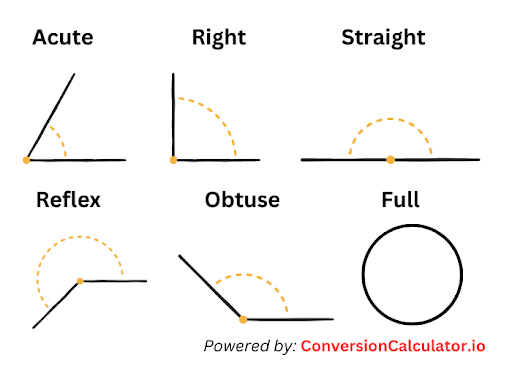
| Type of Angle | Measurement |
|---|---|
| Acute angle | Less than 90° |
| Right angle | Exactly 90° |
| Obtuse angle | Between 90° and 180° |
| Straight angle | Exactly 180° |
| Reflex angle | Between 180° and 360° |
| Full angle | Exactly 360° |
Units of Our Angle Conversion Calculator
Our calculator supports a wide range of different angle unit measurements. You can freely choose and convert between any of the following units instantly:- Degree (°): Degree is the most commonly used unit for measuring angles, where a full circle equals 360 degrees.
- Radian (rad): A full circle equals 2π radians.
- Gon: Gon is also called Gradian. A full circle is equal to 400 gradians.
- Grad: Grad is also known as Gradian. A full circle equals 400 gradians.
- Mil (mils): This unit is generally used for military calculations. One mil equals 1/6400 of a full circle.
- Minute (‘): This angle unit is also called ‘Arcminute’, where one degree equals 60 minutes.
- Point (pt): This unit is used in typography. One point is 1/72 of an inch.
- Revolution (rev): It represents a full turn around a circle. One revolution is equal to 360 degrees.
- Second ("): It is also known as ‘Arcsecond’, where one minute equals 60 seconds.
- Sextant (sext): Sextant is used in navigation, typically expressed in degrees, minutes, and seconds.
- Turn: It’s a unit that represents one complete rotation or 360 degrees or 2π radians.
Angle Conversion Table
Here is a useful angle conversion chart that shows the conversion factors between various angle units. Click the button below to download the full chart. Use it as a quick reference for all your angle calculations.How to Use Our Angle Conversion Calculator?
Using our angle conversion calculator is quick and simple. Just follow these easy steps:- Choose the preferred units you want to convert from and to, like radians to degrees or degrees to seconds.The time you select the units, a real-time formula preview appears that helps you understand how the conversion works between the selected two units.


- Enter the angle value in the ‘Convert from’ field as input.

- The converted result will automatically appear in the desired ‘Convert to’ field.

Features of Our Angle Conversion Calculator
Our angle conversion calculator is designed to make your work easier with a range of handy features. All of them are easy to access through the settings menu.
Adjustable Decimal Precision
When converting angles, especially in technical or scientific fields, you need precise results. Even a small mistake in decimal placement can mess up your entire calculation. That’s why our angle conversion calculator includes an adjustable decimal precision feature, which gives you full control over how exact you want your results to be.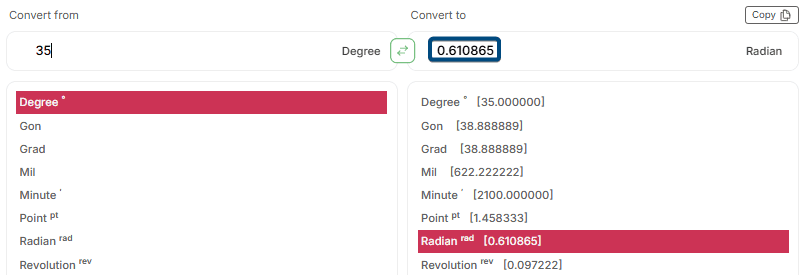

Rounding Mode
In angle conversions, even a small rounding difference matters a lot. Suppose you’re preparing an engineering drawing where the angle must be exactly 65° for accurate machine alignment, but it’s rounded down to 64.9°. This little difference can make the parts not fit the machine correctly.That’s why our calculator lets you control how values are rounded. By default, the rounding mode option remains turned off as follows:


Multiple Number Display Formats
Our calculator lets you choose from three number display formats for your angle conversion results:- Standard Decimal (e.g. 12.34524502)
- Scientific Notation (e.g. 1.2345245e+1)
- Engineering Format (e.g. 1.2345245 × 10^1)
In such cases, switching to scientific format shows it as 3.9e-9°, and engineering format displays it as 3.9 × 10⁻⁹°. These formats make it much easier to read and understand values quickly.Let’s say you’re converting 35 degrees to radians and select scientific notation.


Thousand Separators Toggle
Reading large angle values like 1234567.89 without commas can be confusing, and it’s easy to make mistakes. To help with that, our calculator comes with a Thousand Separator toggle.When you turn it on, large numbers are automatically formatted with commas. For example, 9876543.21 becomes 9,876,543.21, which is much easier to read at a glance Here’s how it looks when the thousand separator is on:


Built-in Calculator
Suppose you’re using an online angle converter for your construction project, and suddenly, you need a quick calculation. Switching to another tool can slow you down and increase the risk of mistakes.That’s why we’ve added a built-in calculator to our angle conversion tool. Now, you can quickly bring converted values into the calculator and use the calculated results directly within the angle converter.

Smooth and Quick Unit Swap
Sometimes, you might need to switch between angle units, like from degrees to minutes and back again. Doing it manually each time can be a hassle. So, we’ve added a simple unit swap button. Just tap it, and it instantly flips the input and output units for you.
Instant Multi-Unit Conversion
When working with angles, you often need to switch between units like degrees, radians, turns, or revolutions. Doing this manually can take time, especially when you need multiple conversions.That's why we introduced the Instant Multi-Unit Conversion feature. It saves your time by automatically calculating and displaying the result in all available units as soon as you enter your value.
For example, if you convert an angle from minutes to seconds, the calculator will instantly display the result in seconds and also give you the corresponding values in other units, like the image below:

Conversion History
When you're working with multiple angle conversions, you might need to quickly check or verify previous results. Repeating the calculations every time can be time-consuming. That's why we've included a feature in our angle conversion calculator that automatically saves your last 10 conversions even after you leave the site.his lets you easily track and access your recent conversions without redoing the work. Simply open the History tab and click any past entry to reload it instantly. Here’s an example:
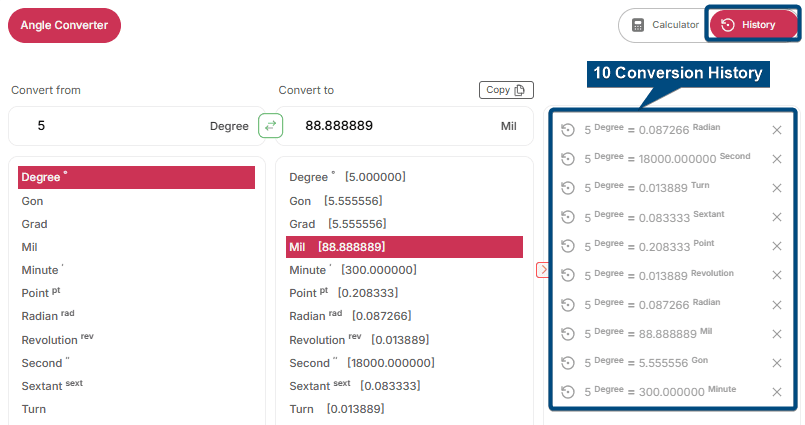
3 Examples of Conversion Using Our Angle Converter
An angle conversion calculator converts between different angle units, such as degrees, radians, and gradians, using predefined conversion factors. These factors are derived from specific mathematical relationships between the units. The conversion formula typically follows this pattern:Source Unit Value × Conversion Factor = Target Unit ValueTo calculate these conversion factors, specific formulas are used for each pair of units. Below is a breakdown of some commonly used conversion factors from the Angle Conversion Chart:ExamplesConversion between Degrees and Radians
To convert degrees to radians, the conversion factor is 0.017453, which is derived from the following formulaSource Unit Value × Conversion Factor = Target Unit ValueRadians = π/180° × Degrees, where π/180° ≈ 0.017453.Similarly, to convert radians to degrees, the conversion factor is 57.29578, which is derived from the following formula:Degrees = 180°/π × Radians, where 180°/π ≈ 57.29578.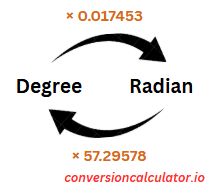
30 × 0.017453 = 0.52359 radians.To convert 2 radians to degrees, the formula is:
2 × 57.29578 = 114.59156 degrees.
Conversion between Turns and Radians
One turn equals 2π radians. To convert turns to radians, use the formula:Radians = Turns × 2π, where 2π ≈ 6.283185 is the conversion factor.
Again, to convert radians to turns, use the following formula:
Turns = Radians × (1 / 2π), where 1 / 2π ≈ 0.15915 is the conversion factor.
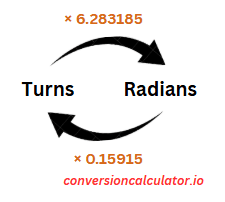
0.48 × 6.283185 ≈ 3.01593 radians.
To convert 5.918 radians to turns, the formula is:
5.918 × 0.15915 ≈ 0.94196 turns.

3.75 × 360 = 1350 degrees.To convert 1440 degrees to revolutions:
1440 × 0.002778 ≈ 4 revolutions.

